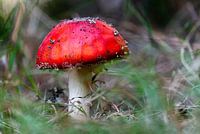Buy this bird art The white-throated dipper by Glenn Vlekke on canvas, ArtFrame, poster and wallpaper, printed on demand in high quality.
About "The white-throated dipper"
by Glenn Vlekke
About the artwork
While the white-throated dipper is mainly found in mountainous areas with fast-flowing streams and rivers in Europe and Asia, sightings of this bird have also been reported in the Netherlands. This photo was taken in Zoetermeer. Although they are less common than in other parts of Europe, white-throated dippers are sometimes spotted in the Netherlands, especially along streams, rivers, and other water-rich areas.
Appearance: The white-throated dipper has a compact body with a striking white belly and a dark, often black, upper part. It also has a distinctive white eye-ring and a short tail. It is a relatively small bird, usually about 14-16 centimeters long.
Habitat: These birds prefer fast-flowing streams and rivers with rocky shores. They are well adapted to life in water-rich areas and are often found along mountain streams and brooks.
Food: The white-throated dipper is an excellent diver and mainly feeds on invertebrates living in the water, such as larvae, small fish, crustaceans, and insects. They dive underwater to catch their prey and can stay submerged for some time.
Nesting: These birds usually build their nests near fast-flowing waters, often behind waterfalls or under bridges. The nest is a compact structure made of mud and grass, usually well hidden from predators.
Behavior: The white-throated dipper has a unique behavior of moving its tail up and down while standing on rocks in the water. This behavior is believed to help in attracting prey or communicating with other birds.
Distribution: Although the white-throated dipper is mainly found in Europe and Asia, there are some isolated populations in North America. However, these populations are not native and are considered escaped or introduced birds.
Threats: Habitat loss, water pollution, and disturbance of river habitats are threats to the white-throated dipper, especially in areas where human activity is more intense.
Overall, the white-throated dipper is a fascinating bird well adapted to life in water-rich habitats and can be an important indicator of the health of river ecosystems.

About Glenn Vlekke
 Germany
Germany Ordered in October 2021
Ordered in October 2021
 Netherlands
Netherlands Ordered in December 2019
Ordered in December 2019
 Netherlands
Netherlands Ordered in June 2020
Ordered in June 2020
 Netherlands
Netherlands Ordered in March 2022
Ordered in March 2022
 Netherlands
Netherlands Ordered in September 2023
Ordered in September 2023
 Germany
Germany Ordered in March 2025
Ordered in March 2025
 Netherlands
Netherlands Ordered in June 2019
Ordered in June 2019
 Netherlands
Netherlands Ordered in December 2021
Ordered in December 2021
 Germany
Germany Ordered in January 2020
Ordered in January 2020
 Germany
Germany Ordered in March 2024
Ordered in March 2024
 Germany
Germany Ordered in February 2020
Ordered in February 2020
 Netherlands
Netherlands Ordered in September 2025
Ordered in September 2025
About the material
ArtFrame™
Interchangeable Art Prints
- High-quality print
- Easily interchangeable
- Acoustic function
- Large sizes available
Discover the artworks of Glenn Vlekke
 Tulip in the fieldGlenn Vlekke
Tulip in the fieldGlenn Vlekke Swan with youngsGlenn Vlekke
Swan with youngsGlenn Vlekke Swans youngGlenn Vlekke
Swans youngGlenn Vlekke South Africa at sunsetGlenn Vlekke
South Africa at sunsetGlenn Vlekke TickGlenn Vlekke
TickGlenn Vlekke Highland cattle with sunsetGlenn Vlekke
Highland cattle with sunsetGlenn Vlekke Duck on iceGlenn Vlekke
Duck on iceGlenn Vlekke DuckGlenn Vlekke
DuckGlenn Vlekke Hawthorn flowerGlenn Vlekke
Hawthorn flowerGlenn Vlekke landscape with cloudsGlenn Vlekke
landscape with cloudsGlenn Vlekke mountains landscape with water sun and rain with beautiful cloudsGlenn Vlekke
mountains landscape with water sun and rain with beautiful cloudsGlenn Vlekke Flat piece on a mountain with fjord in the backgroundGlenn Vlekke
Flat piece on a mountain with fjord in the backgroundGlenn Vlekke Landscape: Mountains where the clouds reflect into the lakeGlenn Vlekke
Landscape: Mountains where the clouds reflect into the lakeGlenn Vlekke Autumn Mushroom FallowrussulaGlenn Vlekke
Autumn Mushroom FallowrussulaGlenn Vlekke Veluwe forest at the start of autumnGlenn Vlekke
Veluwe forest at the start of autumnGlenn Vlekke Hellefot lock at sunsetGlenn Vlekke
Hellefot lock at sunsetGlenn Vlekke Rough forest in the black forestGlenn Vlekke
Rough forest in the black forestGlenn Vlekke CrocusGlenn Vlekke
CrocusGlenn Vlekke DuckGlenn Vlekke
DuckGlenn Vlekke Tauros beefGlenn Vlekke
Tauros beefGlenn Vlekke













 Animals
Animals Birds
Birds Photo wallpaper
Photo wallpaper Photography
Photography Serene Peace
Serene Peace Starlings
Starlings Water
Water









